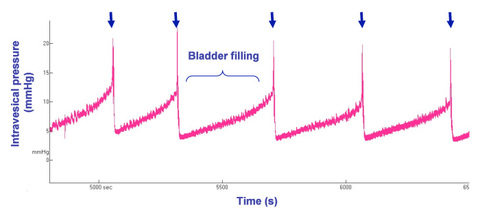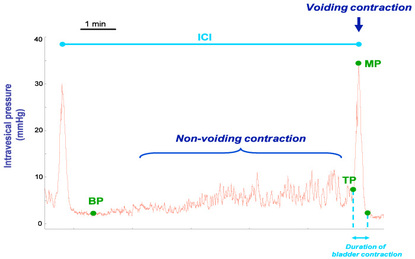Urodynamic evaluation (cystometry experiments)
Objectives
- To explore bladder function by measuring intravesical pressure during bladder filling until the point of fullness which elicits a voiding response
- performed in either anaesthetised (isoflurane) or conscious (metabolic cage) animals
- performed in either normal or pathophysiological animal models
SPECIES
rat, guinea pig
 |
| Figure 1: Representative cystometrograms in an anesthetized normal rat. Arrows indicate the voiding contractions. |
Summarized methodology
A bladder dome catheter is inserted allowing continuous filling of the bladder with saline (50 Ál/min for normal rats or 300 Ál/min for guinea pigs) and simultaneous measurement of intravesical pressure.
For experiments in conscious animals, the intravesical catheter implantation is performed 48 hours before the cystometry experiment. The free end of the bladder catheter is tunneled subcutaneously, exteriorized at the back of the neck and sutured between the scapulas. Animals are allowed to recover at least for 48 h after surgery until cystometry experiment.
Endpoints
- maximal amplitude (MP, mm Hg) and duration of voiding contractions (s)
- baseline intravesical pressure (BP, mm Hg)
- micturition pressure threshold (PT, mm Hg, intravesical pressure at which voiding is initiated),
- intercontraction interval (ICI, s)
- voided volume
For chronic pathophysiological models: non-voiding contractions during the bladder filling phase are also analyzed :
- amplitude of non-voiding contractions for each micturition cycle(mm Hg),
- frequency for each micturition cycle (number of non-voiding contractions per min)
 |
| Figure 2: Representative cystometrograms in a conscious rat with overactive bladder illustrating the parameters analysed from such experiment. |

Links to applicable Targeted disorders / Pathophysiological models





















 Download this page in PDF
Download this page in PDF